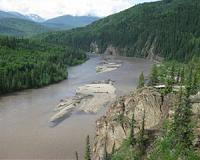| . |  |
. |
Leicester, UK (SPX) Mar 30, 2011 Researchers from China, Leicester and Oxford have discovered a remarkable fossil which sheds new light on an important group of primitive sea creatures. The 525-million-year-old fossil belongs to a group of tentacle-bearing creatures which lived inside hard tubes. Previously only the tubes have been seen in detail but this new specimen clearly shows the soft parts of the body including tentacles for feeding. Details of the discovery have been announced in the journal Current Biology. The study was funded by the Royal Society and the National Natural Foundation of China. The creature belongs to a group called pterobranch hemichordates which are related to starfish and sea urchins but also show some characteristics that offer clues to the evolution of the earliest vertebrates. About 30 species of pterobranch are known to exist today although 380-490 million years ago a group of these animals called graptolites were common across the prehistoric oceans. Pterobranches are creatures which secrete a substance that builds up into a hard tube around their soft body. Tentacles extend from the top of the tube to catch plankton. Although less than 4cm in length, the new fossil is beautifully preserved and minute details can be seen including 36 tiny tentacles along one feathery arm. Professor David Siveter from the University of Leicester's Department of Geology commented, "Amazingly, it has exceptionally preserved soft tissues - including arms and tentacles used for feeding - giving unrivalled insight into the ancient biology of the group." Colleagues from Yunnan University and the Universities of Leicester and Oxford collaborated in identifying and describing the remarkable find which was discovered in Yunnan Province, China. It has been named Galeaplumosus abilus which means 'feathered helmet from beyond the clouds', referring to both the creature's shape and its location - 'Yunnan' literally translates as 'south of the clouds'. The team from Yunnan (Professor Hou and Dr Ma), Leicester (Professors David Siveter and Richard Aldridge; Drs Mark Williams and Jan Zalasiewicz) and Oxford (Professor Derek Siveter) are engaged in long term study of these important fossils. Hou, Xian-guang, Aldridge, R.J., Siveter, David J., Siveter, Derek J.,Williams, M., Zalasiewicz, J.A. and Ma Xiao-ya. 2011. A pterobranch hemichordate zooid from the lower Cambrian. Current Biology.
Share This Article With Planet Earth
Related Links University of Leicester Explore The Early Earth at TerraDaily.com
 Even Canadian Rocks Are Different
Even Canadian Rocks Are DifferentCalgary, Canada (SPX) Mar 30, 2011 Canadians have always seen themselves as separate and distinct from their American neighbours to the south, and now they have geological proof. New research published in April's edition of Geology shows that rock formations roughly along the same political boundary as the two North American countries formed as early as 120 million years ago. Dr. Andrew Leier, of the Department of Geo ... read more |
|
| The content herein, unless otherwise known to be public domain, are Copyright 1995-2010 - SpaceDaily. AFP and UPI Wire Stories are copyright Agence France-Presse and United Press International. ESA Portal Reports are copyright European Space Agency. All NASA sourced material is public domain. Additional copyrights may apply in whole or part to other bona fide parties. Advertising does not imply endorsement,agreement or approval of any opinions, statements or information provided by SpaceDaily on any Web page published or hosted by SpaceDaily. Privacy Statement |